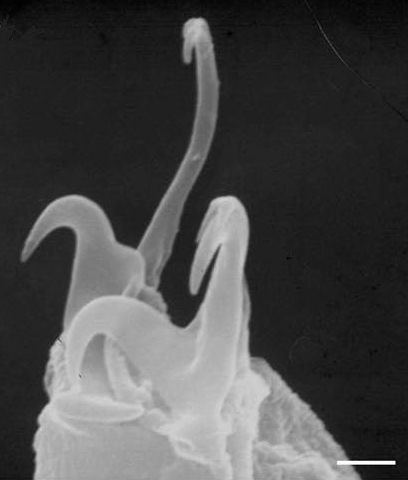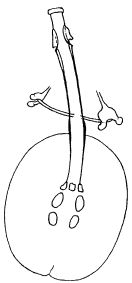Hypsibioidea from Pilato 1969 in Marley et al. 2011: “Parachela; claws asymmetrical (2121); Hypsibius-type claw pairs; AISM hooked (or, if the buccal tube is elongated, AISM can be broad ridges).”
Hypsibioidea from Bertolani et al. 2014: “Double claws asymmetrical with respect to the median plane of the leg (2121), the external (or posterior) claw often with flexible main branch; double claws different in size and shape on the same leg (Hypsibius and Ramazzottius type, or modified), or very reduced in size (Calohypsibius and Microhypsibius type); buccal tube often very narrow”
Hypsibioidea from Gąsiorek et al. 2018: “Eutardigrades with asymmetrical claws (2-1-2-1) and pseudolunulae at claw bases or without any cuticular structures under the basal parts. Hooked or broad-ridged apophyses for the insertion of the stylet muscles. Herbivorous or microbivorous (Guidetti et al. 2012).”
Ramazzottiidae from Marley et al. 2011: “Hypsibioidea. The AISM comprises asymmetric, dissimilar dorsal and ventral ‘blunt hooks’. Claw pairs asymmetric (2121), external claw primary branch joins the secondary claw and basal section with flexible junction; primary branch may be very long and slender; the internal claw branches and basal section unified into a single rigid element. Eggs have a sculptured chorion and are deposited free in the environment.”
Ramazzottiidae from Bertolani et al. 2014: “Double claws different in shape and size on the same leg, the external (or posterior) claw with the primary branch connected to basal tract with an evident, thin, flexible tract (Ramazzottius or oberhaeuseri type, or modified), or completely disconnected. Eggs laid freely and with ornamented shell.”
Genus description from Binda & Pilato 1986: “Hypsibiidae con unghie di tipo oberhaeuseri; le due diplounghie di ciascuna zampa molto diverse fra loro; apparato bucco-faringeo costruito secondo il modello Hypsibius con tubo boccale rigido e apofisi per l’inserzione dei muscoli degli stiletti ‘ad uncino smussato’ e asimmetriche rispetto al piano frontale; è presente un organo sensoriale ellittico dorsolaterale sul capo; uova deposte libere e col guscio provvisto di sporgenze; lamelle periboccali assenti, le lunule possono essere presenti anche se molto piccole. Nelle specie finora note il bulbo faringeo contiene le apofisi faringee e soltanto 2 macroplacoidi; finora mai segnalati il microplacoide e il septulum.”
Translated: “Hypsibiidae with oberhaeuseri claws; the two double-claws of each leg very different from each other; bucco-pharyngeal apparatus constructed according to the Hypsibius model with a rigid buccal tube and apophyses for the insertion of the muscles of the stylets ‘blunted’ and asymmetric with respect to the frontal plane; there is a dorsolateral elliptic sensory organ on the head; eggs laid free and with the shell provided with protrusions; peribuccal lamellae absent, the lunulae may be present although very small. In the species known so far, the pharyngeal bulb contains the pharyngeal apophyses and only 2 macroplacoids; so far the microplacoid and the septulum were never reported.”




Citations:
Bertolani R, Guidetti R, Marchioro T, Altiero T, Rebecchi L, Cesari M. 2014. Phyloeny of Eutardigrada: New molecular data and their morphological support lead to the identification of new evolutionary lineages. Molecular Phylogenetics and Evolution. 76: 110-126.
Binda MG, Pilato G. 1986. Ramazzottius, nuovo genere di eutardigrado (Hypsibiidae). Animalia. 13: 159-166.
Gąsiorek P, Stec D, Morek W, Michalczyk Ł. 2018. An integrative redescription of Hypsibius dujardini (Doyère, 1840), the nominal taxon for Hypsibioidea (Tardigrada: Eutardigrada). Zootaxa. 4415 (1): 45-75.
Marley NJ, McInnes SJ, Sands CJ. 2011. Phylum Tardigrada: A re-evaluation of the Parachela. Zootaxa. 2819: 51-64.
Pilato G. 1969. Schema per una nuova sistemazione delle famiglie e dei generi degli Eutardigrada. Bollettino delle Sedute della Accademia Gioenia di Scienze Naturali in Catania, Series IV. 10 (277): 181-193.
